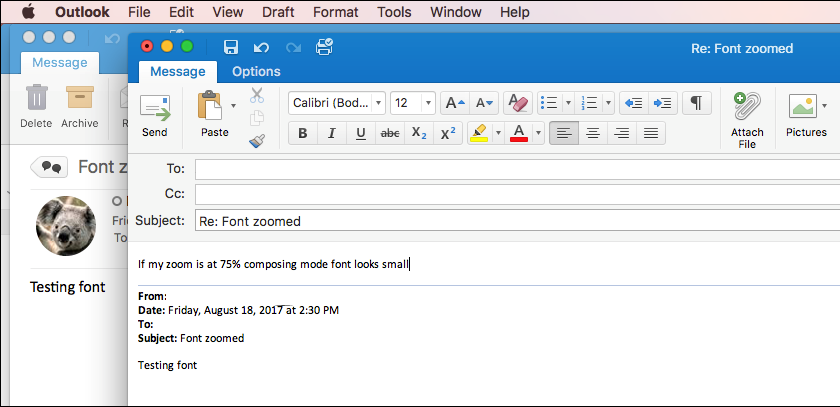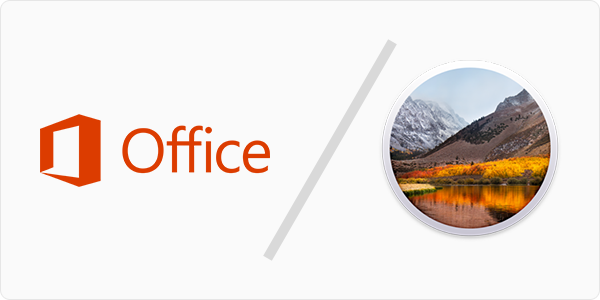Is Office 2011 For Mac Compatible With High Sierra
There are plenty of apps, like Microsoft Word 2011 and the other components of Office 2011, which work quite well still in Sierra, but whose file open and save dialogs don’t work properly, and which don’t give access to iCloud Drive.
If you fancy paying a monthly subscription and upgrading to Office 365, its component apps do work well now with iCloud Drive. Couple them with the iOS versions, and you can use iCloud for all your shared Office tasks. But you have to pay the subscription to Microsoft, as well as paying Apple for your iCloud storage.
- Office for Mac Home and Student 2011 A Mac computer that has an Intel processor; Mac OS X version 10.5.8 (or a later version) 1 gigabyte (GB) or more of memory (RAM) 2.5 GB of available hard disk space; HFS+ hard disk format (also known as Mac OS Extended or HFS Plus) 1280 x 800 or higher resolution monitor.
- Microsoft has warned users of Office for Mac 2011 not to upgrade to Apple's macOS High Sierra when the new operating system launches next month. 'Word, Excel, PowerPoint, Outlook and Lync have not.
Office for Mac 2011. Word, Excel, PowerPoint, Outlook and Lync have not been tested on macOS 10.13 High Sierra, and no formal support for this configuration will be provided. Since October 10, 2017, Office for Mac 2011. is no longer supported. This means there will be no new security updates, non-security updates, free or paid assisted support options, or technical content updates.
Negotiating file open and save dialogs in Office 2011 apps running under Sierra is kludgy: trackpad controls move the pointer, but the pointer doesn’t let you navigate the folder and file view within the dialog. However, the cursor keys do function normally, so you can use them to traverse folders and files. This is not a heart-warming experience, but it gets by.
Sierra’s file open and save dialogs should include your iCloud Drive in the list of favourites on the left (as shown above), but Office 2011 and many other older apps may not give direct access to files in your iCloud Drive.
To enable that access, use aliases.
Let’s say we have two folders in our iCloud Drive named Excel and Word, to contain documents shared with other Macs or iOS devices using the same iCloud account. Select each, and use the contextual menu (or any other method) to make an alias to the folder. Move that alias into your local Documents folder: because that will remove the alias from iCloud Drive, you’ll see a warning that the aliases will be deleted. That’s just what you want.

With those aliases in place in Documents, you can now open and save to files on your iCloud Drive in Office 2011 and most other older apps, just as if the aliased folder was on your internal drive. You may also find that, once an old app has accessed your iCloud Drive via aliases, it then decides to add iCloud Drive to your list of favourites!
The only remaining glitch is that Sierra 10.12 often shows folder aliases as if they were documents. Don’t be put off: they still work correctly.
Posted on June 11, 2020 byBack in 2016, we blogged about deploying MariaDB 10.1.16 on Mac OS X with Homebrew. We’ve refreshed this blog to reflect the latest technology. Homebrew now includes MariaDB 10.4, 10.3, 10.2, and 10.1 for macOS. Mariadb for mac os x yosemite. If you need the old blog, you can find it. Install XcodeRun xcode-select -install.
Check compatibility
You can upgrade to macOS High Sierra from OS X Mountain Lion or later on any of the following Mac models. Your Mac also needs at least 2GB of memory and 14.3GB of available storage space.
Rsync for mac os x lion. MacBook introduced in late 2009 or later
MacBook Air introduced in late 2010 or later
MacBook Pro introduced in mid 2010 or later
Mac mini introduced in mid 2010 or later
iMac introduced in late 2009 or later
Mac Pro introduced in mid 2010 or later
To find your Mac model, memory, storage space, and macOS version, choose About This Mac from the Apple menu . If your Mac isn't compatible with macOS High Sierra, the installer will let you know.
Make a backup
Before installing any upgrade, it’s a good idea to back up your Mac. Time Machine makes it simple, and other backup methods are also available. Learn how to back up your Mac.
Get connected
It takes time to download and install macOS, so make sure that you have a reliable Internet connection. If you're using a Mac notebook computer, plug it into AC power.
Download macOS High Sierra
For the strongest security and latest features, find out whether you can upgrade to macOS Catalina, the latest version of the Mac operating system.

If you still need macOS High Sierra, use this App Store link: Get macOS High Sierra.
Begin installation
After downloading, the installer opens automatically.
Click Continue and follow the onscreen instructions. You might find it easiest to begin installation in the evening so that it can complete overnight, if needed.
If the installer asks for permission to install a helper tool, enter the administrator name and password that you use to log in to your Mac, then click Add Helper.
Allow installation to complete
Please allow installation to complete without putting your Mac to sleep or closing its lid. Your Mac might restart, show a progress bar, or show a blank screen several times as it installs both macOS and related updates to your Mac firmware.
Office 2011 For Mac Amazon
Learn more
Office 2011 For Mac Release
- If you have hardware or software that isn't compatible with High Sierra, you might be able to install an earlier macOS, such as Sierra or El Capitan.
- macOS High Sierra won't install on top of a later version of macOS, but you can erase your disk first or install on another disk.
- You can use macOS Recovery to reinstall macOS.